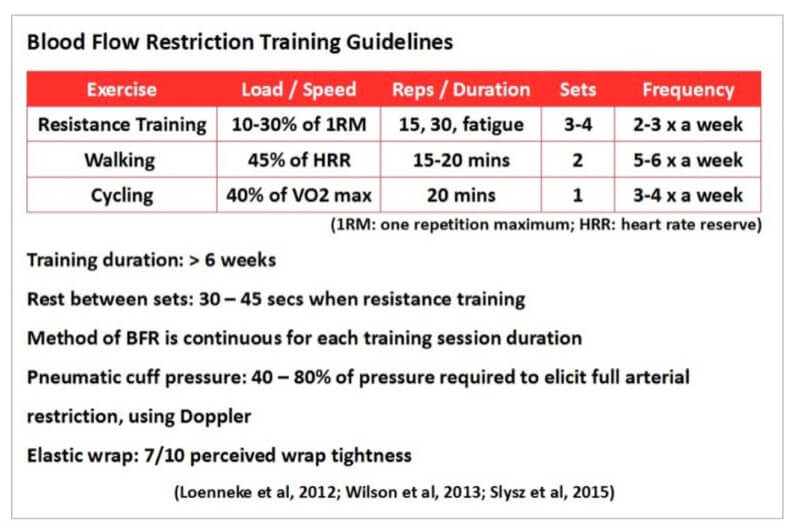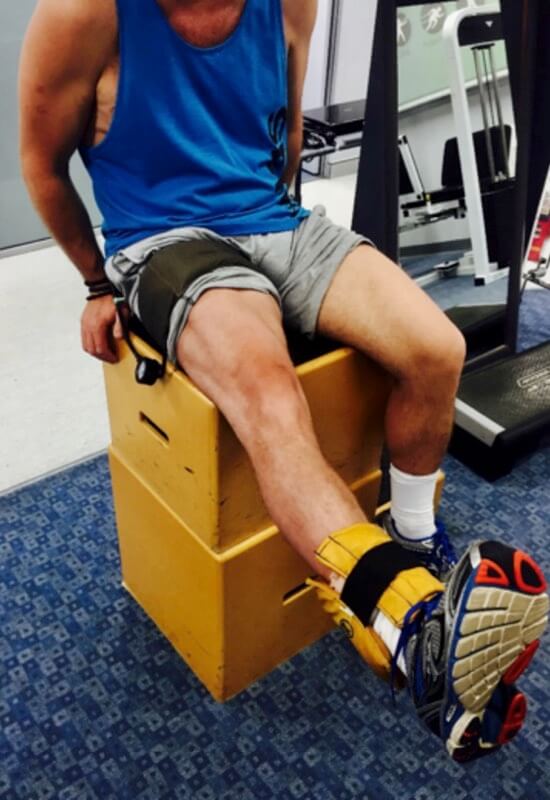Occlusion training or Blood flow restriction training (BFRT) is being used more and more by physiotherapists, exercise physiologist or other trained allied health professionals to assist with improving muscle hypertrophy in a range of general and clinical populations.
It works by using compression at the proximal limb to limit blood flow out of the muscle.
Research has shown BFR training to increase muscular strength and hypertrophy using loads less than half of what is recommended by the ACSM for general hypertrophy training (60% of 1RM).
It is proposed that occlusion training works by altering the traditional ratio of mechanical loading and metabolic stress to give similar outcomes without high mechanical loads – perfect in a rehab setting.
How Blood Flow Restriction Training Work?
The occlusion cuff compression limits venous return (blood flow out of the muscle) causing venous pooling. Be careful to not elicit full arterial restriction (don’t wrap too tight).
This causes greater metabolic stress via elevated blood lactate levels which leads to increase growth hormone and IGF-1 (anabolic protein)
Studies have shown BFRT elicits increased fast-twitch fibre recruitment
BFRT has also shown to increase; cell swelling and protein synthesis
When to use BFRT:
More recent research suggests the use of BFRT to be useful to elicit improvements to quad/hamstring and lower limb strength, power and total workload in the rehabilitation of osteoarthritic knee pain, post-op ACL-reconstruction, osteochondral fractures and other lower limb pathologies in which heavy lifting (>60% 1RM) may be contraindicated.
BFRT may be contra-indicated if you have deep vein thrombosis, varicose veins, high blood pressure, history of stroke or cardiac disease or during pregnancy.
Always consult your accredited Exercise Physiologist before starting BFRT to ensure this is appropriate for you.
How to implement BFRT:
The use of a Sports Rehab tourniquet is best practice for Blood Restriction Training this is due to its ability to objectively measure the amount of pressure being applied.
As discussed above, the goal of occlusion training is to restrict venous return rather than occlude blood flow to the limb. For this reason, it is advised that pressure of 90-120mmHg is optimal. Once the compression has been applied the prescription of appropriate exercises at a specific rep & set range needs to be determined.
The following figure gives an outline as towards appropriate load, reps, sets and frequency.

Clinical Case Review:
Mr John arrived at our clinic 9 months’ post-op right knee injury (medial femoral condyle & trochlear lesion). He reported being unable to regain quadriceps and hamstring strength due to intense pain with squat, lunge or other lower limb activities.
Upon initial assessment Mr John was unable to stand from a sitting position without patellar femoral join pain >7/10 PVAS (front of knee pain), strength testing revealed his quadriceps strength was 45% compared to his left leg and hamstring strength 55% of his left side, he had noticeable quadriceps atrophy (muscle wasting) and was unable to walk, stand or drive his car for extended periods of time.
After 12 weeks of BFRT training (2 x sessions per week) Mr John can now complete repetitive lunges, squats too parallel and stairs with only very minimal discomfort.
He reports walking to be pain free and has even started to complete loaded step ups & squats with loads up to 15kg. His quadriceps and hamstring strength testing reveals significant improvements (Quadriceps 90% and Hamstring 85% of his left side respectively).
Due to Mr John being unable to handle high mechanical loads required to achieve hypertrophy gains BFRT allowed him to build the required lower limb strength to return to work and complete most of his activities of daily living without restrictions.
References:
BJSM Blog – Paul Head (2016) Can blood flow restriction training improve outcomes in clinical populations?
Loenneke, J. P., & Pujol, T. J. (2009). The use of occlusion training to produce muscle hypertrophy. Strength & Conditioning Journal, 31(3), 77-84.
Wernbom, M., Paulsen, G., Nilsen, T. S., Hisdal, J., & Raastad, T. (2012). Contractile function and sarcolemmal permeability after acute low-load resistance exercise with blood flow restriction. European journal of applied physiology, 112(6), 2051-2063.

